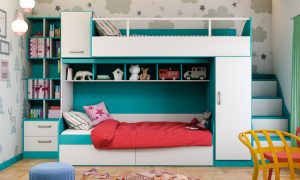Designing your kid’s room is an exciting opportunity to create a space that reflects their personality, fosters their growth, and provides a comfortable haven for sleep and play. It’s a room that will transform over the years, but with some careful planning and consideration, you can create a foundation that adapts to their changing needs while remaining a place they love. Here’s a guide to help you design your kid’s room, taking you through key elements, themes, and clever storage solutions.
Plan with Your Child (Age Appropriately)
Involving your child in the design process, even if they’re young, is a great way to get them excited about their new space. For younger children, this might involve showing them colour palettes or pictures of furniture and letting them choose their favourites. Older children can have a more significant say in the overall design, from picking themes to selecting furniture.
Prioritize Function and Flexibility
A child’s needs will change rapidly as they grow. To ensure the room stays functional, prioritize flexibility. Consider furniture that can grow with your child, like a loft bed with a play area underneath or a desk that converts into a larger workspace. Designing your kid’s room with ample storage is also crucial. Opt for built-in storage solutions, modular furniture, and ottomans with hidden compartments to keep toys, clothes, and books organized.

Create Designated Zones
A well-designed kid’s room should cater to different activities. Divide the space into zones for sleeping, playing, studying, and relaxing. This will help your child develop routines and encourage them to use the space efficiently.
Sleep Zone:
This is where your child will unwind and recharge. Keep the décor calming and the lighting soft. Choose comfortable bedding and invest in blackout curtains if needed.
Play Zone:
This is where your child’s imagination can run wild. Designing your kid’s room with a designated play area allows you to keep toys contained and organized. Consider a playmat for younger children or a dedicated craft area for older ones.
Study Zone:
As your child gets older, they’ll need a dedicated space for homework and studying. Ensure this area has a comfortable desk and chair with good lighting.
Embrace Storage Solutions
Keeping a child’s room organized can feel like a constant battle. Designing your kid’s room with clever storage solutions is key. Utilize vertical space with wall-mounted shelves and cabinets. Opt for storage ottomans, chests, and bins that double as seating or play areas. Label shelves and drawers to encourage your child to put things away independently.
Light Up the Room (Naturally and Artificially)
Natural light is essential for a child’s well-being and development. Position the bed and work area near a window. Layering different types of lighting will also create a more functional and inviting space. To create a pleasant atmosphere, try combining task lighting for the study area, ceiling lighting, and a dimmer switch.
Let There Be Color (But Strategically)
Color can significantly impact a child’s mood and energy levels. Designing your kid’s room with bright and cheerful colours can create a stimulating environment for play, while calmer hues promote relaxation in the sleep zone. Consider using paint, wallpaper, or colourful accents to add personality to the space.
Don’t Forget the Details
The finishing touches are what make a room feel personal and complete. Designing your kid’s room with decorative elements like artwork, rugs, and throw pillows allows you to incorporate your child’s personality and interests. Encourage them to choose artwork they love or create a gallery wall showcasing their creations. A cozy rug can define the play area and add warmth to the space, while throw pillows add pops of colour and comfort.
Safety First
Use outlet covers, buy furniture with rounded corners to reduce bumps and bruising, and anchor furniture to the wall to prevent it from toppling over. Install nightlights for a comforting glow and ensure all electrical cords are tucked away securely.
Conclusion: Designing Your Kid’s Room
Designing your kid’s room is a journey, not a destination. Embrace your child’s unique personality and create a space that fosters their growth and imagination. Remember, the most important thing is to create a room where your child feels safe, loved, and inspired.